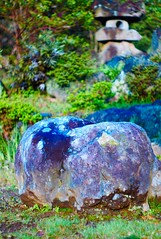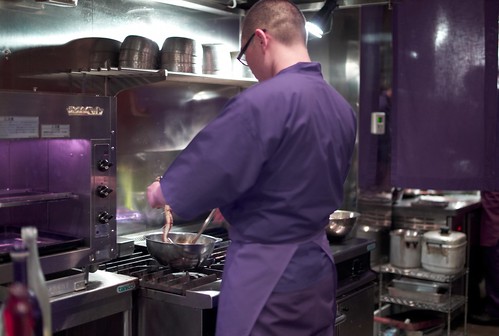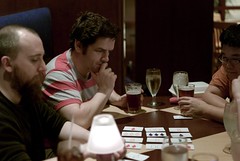Version 1.4 of my Nukamiso guide. Nukamiso is a Japanese pickling process.


|

My nukamiso in old ceramic urn.
|
|

My nukamiso in newly acquired cedar tub.
|
Nukamiso (Version 1.4)
By Joichi Ito
August 10, 1998
Last Revised April 4, 1999
Why we mix the Nukamiso
The Nukamiso needs to be mixed at least twice a day in the summer and
once a day in the winter. If the Nukamiso is not mixed regularly the following
may occur:
- Bugs such as small flies may collect and lay eggs.
- The Nukamiso may turn sour. See procedure for dealing with sour Nukamiso
below.
Procedure for mixing the Nukamiso
- Clean hands and dry thoroughly.
- Prepare paper towel for wiping container.
- Mix Nukamiso thoroughly taking care to mix the bottom of the container.
Remember, the main point of mixing the Nukamiso is to allow it to contact
air.
- Try to keep Nukamiso fluffy and not compressed in order to allow air
to stay mixed with the Nukamiso afterwards.
- After mixing thoroughly, pat the surface of the Nukamiso to make sure
it is flat. (This is to insure that water does not collect in wells
in the surface.
- Wipe sides inside of container to make sure there are is no Nukamiso
on the walls.
- Close container and store.
Procedure for inserting vegetables into Nukamiso
- (Optional) Wash Vegetables.
- Cut vegetables.
- Do not cut cucumbers.
- Cut daikon into short quarters.
- Cut kabu into quarters or eighths.
- Rub salt onto vegetables. If vegetables are dry, wet hands and rub
salt on vegetables with wet hands.
- Bury vegetables in Nukamiso.
- Vegetables buried deeper in container will pickle faster.
- Lay long vegetables flat so that they pickle evenly.
- Flatten surface of Nukamiso, wipe walls, close and store as in Procedure
for mixing Nukamiso
Pressure during flattening
Increased pressure on the Nukamiso while flattening will increase the
speed of fermenting but will increase the risk of suffocating the Nukamiso
causing a fermentation error. Leaving the Nukamiso too fluffy will slow
down the process and may cause irregular pickling on the vegetable surface.
Duration to pickle vegetables
In general cucumbers should be pickled for 4-5 hours, daikon for 10 hours.
okura for 1-2 hours., shirouri for 4-5 hours, and carrots and eggplant
for 10-12 hours, kabu for 15 hours. The duration must be adjusted to reflect
the seasonal changes in temperature. These durations are for summer pickles.
In spring and fall cucumbers should be pickled for 10 hours or so and
in the winter 16 hours or so. Adjust the durations for other vegetables
using a similar scale. Because it is the temperature that affects the
speed of fermentation, the temperature of the room is what ultimately
determines how long to pickle vegetables.
Procedure for removing vegetables from Nukamiso
- Find vegetables in Nukamiso and remove without wiping excess Nukamiso
off of vegetables.
- After removing vegetables, mix, flatten, wipe walls, close and store
and in Procedure for mixing Nukamiso.
- Wash vegetables in cold water.
- Cut and serve.
Procedure for increasing Nukamiso
Twice a month or so, the Nukamiso must be increased. nuka, salt, chopped
red chili peppers and kombu should be added. Nuka and salt should be added
at a ratio of 500g nuka for 95g salt. It is recommended by some that some
of the old Nukamiso be discarded during this procedure to allow for more
new Nuka.
Wet Nukamiso
Wet Nukamiso can suffocate the fermentation process.
To decrease water level, use a device designed for this or a combination
of some kind of sieve and paper towels to soak up extra moisture.
Procedure for fixing sour Nukamiso
- Add eggshells or add a mixture of Japanese mustard, eggshells and
other things designed to help sour nukamiso.
- Keep lid a little off center and allow air to enter container. Mix
3 or more times a day.
- Increase the salt content to slow down the fermentation process.
Why Nukamiso turns Sour
Too little air (not enough mixing or too watery) or chemicals (hand cream)
can cause the fermentation process have problems and leave an acidic material
that causes the nukamiso to turns sour. Mixing frequently and removing
exccess water are is important in preventing such a crisis.
Initializing the Nukamiso
- Add 380g of salt to 2300cc of water and bring water to a rapid boil.
- Cool the water and add slowly to 2kg of nuka mixing and kneading while
adding the water.
- Add 5-6 dried red-hot chili peppers chopped into rings and 10g of
dashi kombu cut into thin strips and mix thoroughly.
- Insert cheap vegetables such as cabbage or hakusai following the procedure
for inserting vegetables.
- A day or so later, remove vegetables, throw the vegetables away and
repeat step 4. Repeat one or two more times until Nukamiso has come
alive.
- White bread and beer can be added at step 4 to increase speed of fermentation.
1 slice of bread and 150cc of beer or so is sufficient. The bread should
be torn into small pieces.
- Mature Nukamiso from another culture can be added after step 5 to
increase the flavor and complexity of the Nukamiso.
The Container
I've seen people use plastic bags, tupperware, plastic buckets, ceramic
urns, and cedar tubs. Wood seems to be the best because it allows some
air through and adds flavor. Used sake "taru" are supposed to
be quite good. Also, since one wants to lay the vegetables flat, remember
that the container should be as wide as the largest vegetables are long.
The Old Refrigerator Trick
Some people put the nuka in the refrigerator and only mix it a few times
a week. It takes vegetables a long time to pickle, but the care is quite
easy. I've never tried this, but I can't imagine that the nukamiso is
very happy or the pickles would taste that great, but if you can't deal
with mixing it everyday, it might be worth a try.
Dealing With Your Nukamiso When You Travel
If you are leaving for a few days, you can cover the top of the nukamiso
with salt and stick it in the refrigerator. When you return, throw away
the top layer of nukamiso. If you need to leave the nukamiso for more
than a few days, leave it with a friend that you trust. Remember that
the nukamiso will start to taste like your friend so choose a friend that
you like.
Material added to Nukamiso
Nails - The iron in the nails prevents eggplant surfaces from oxidizing
and turning brown. Iron paperweight sized products are available which
do the same thing.
Garlic - Garlic adds flavor and aroma.
Chips of Katsuobushi - Katsuobushi is the dried makerel used to make
the shavings used for Japanese cooking. Pieces chip off during the shaving
process and these pieces can be inserted into the Nukamiso. They add a
nice woody flavor to the Nukamiso.
Japanese Mustard - Helps control the fermentation of Nukamiso.
Dried Shiitake Mushrooms - Adds flavor and aroma.
Bread Crumbs - Helps fermentation and adds flavor.
Beer - Helps fermentation and adds flavor.
Chili Peppers -Helps control fermentation, adds flavor.
Dashi Kombu - Dried kelp used for making broth in Japanese cooking. Adds
flavor and depth to Nukamiso.
Salts - Salt is the single most important part of the Nukamiso. Too much
kills the flavor, too little lets the fermentation get out of control.
The balance of the salt on the vegetable is essential for the final saltiness
of the pickle.
The Art of Nukamiso
There are many things that affect the character of Nukamiso. My friends
in Kyoto add beer, bread, garlic, konbu and chili peppers. My friend in
Tsukiji uses only broken pieces of dried katsuo (for katsuobushi) and
konbu and chili peppers (un-chopped). My Nukamiso is a combination of
three 50 year old Nukamiso's and a 25 year old Nukamiso, two from Kyoto
and two from Tokyo. Nukamiso evolves and older Nukamiso's have a much
more complex flavor and character. Everyone agrees that one must use one's
bare hands. When Nukamiso is in good character it is a pleasure to mix
and the smell can make one salivate. On the other hand, Nukamiso in bad
character smells like garbage or very sour. Mixing frequently, above all
else is the most important thing. After that, it appears that the ammount
of salt in the Nukamiso is another key factor. It is difficult to smell
the salt, so one should taste one's hands after mixing to check the level.
It can be adjusted by adding salt directly or salting vegetables more
heavily or lightly depending on the adjustment. Finally, it is important
to feed the Nukamiso so even if there are is no need to pickle anything,
pickling even throw-away vegetables regularly to keep the Nukamiso in
shape is important in maintaining flavor.
Release Notes
Version 1.4 4/4/99 - Added seasonal time difference, material added to
and packing pressure sections.
 I ended the work day with a study group and an expert guest where we discussed the Japanese legal system. Although there were some small signs of hope, I find that the more I learn about how things really work, the more pessimistic I get about causing actual change in Japan.
I ended the work day with a study group and an expert guest where we discussed the Japanese legal system. Although there were some small signs of hope, I find that the more I learn about how things really work, the more pessimistic I get about causing actual change in Japan.![Joi Ito [logo]](/_site/img/joi-ito-logo-300.png)








 JUMP系列 Photographer:老0
JUMP系列 Photographer:老0

























































































































































































